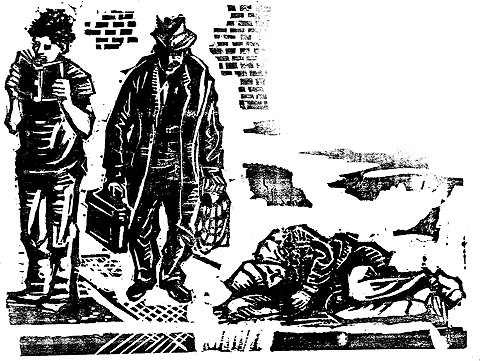 |
||||||||||||
|
November/December 2013
BY CAROL GARDNER
The graduation rate is one way VSF measures success. Another is staying financially solvent in the face of constantly fluctuating funding sources. Since the beginning the VA has been VSF’s primary partner. But the support the VA provides—and the rules by which it operates—have changed. VSF’s Supportive Housing Program has managed to survive and thrive in part because it is small and lean; it serves some fifty veterans each year with two full-time and three part-time staff. VSF has also been resourceful; when sources of funding have dried up, the staff and board have managed to find others. The highly structured environment at VSF residences enables homeless veterans to make the transition to independent, productive lives.
In the early 1990s advocacy groups estimated that between two and three million Americans were homeless, and the problem was especially acute among veterans. In 1994 the Veterans Support Foundation (then known as Vietnam Veterans Assistance Fund) began building its Supportive Housing Program for Homeless Veterans in Connecticut. The idea was to offer homeless veterans a place to live while they underwent treatment and rehabilitation at a nearby VA Medical Center. VSF had its headquarters in Washington, D.C., but choosing Connecticut for its housing program was no accident. The Connecticut Department of Social Services was offering state and federal funds to buy housing for homeless veterans, and the VA-Connecticut Healthcare System’s West Haven campus was a willing partner. VSF located several houses, and applied for—and won—grants to buy them. Over the next two years the organization bought and renovated four properties in residential sections of West Haven. VA funds covered 65 percent of the costs; VSF contributed the rest. Each house had six or nine bedrooms and multiple kitchens. A homeless veteran entering the program was given his own room, but he shared a kitchen and bathroom with two other residents and shared the rest of the house with all residents. Originally veterans could reside in these homes for up to two years as they continued their VA treatment programs and worked on the issues that had caused their homelessness: substance abuse, PTSD, unemployment, and lack of a family or community support system. Veterans were required to be sober and drug-free for ninety days before being accepted into the program. They agreed to keep their rooms and common areas clean, not to have visitors without permission, and not to smoke inside the buildings. They were required to attend weekly house meetings and to spend twenty hours a week engaged in productive activities outside the houses, such as treatment programs, classes, volunteer work, and employment. Veterans who didn’t follow the rules were asked to leave. Today VSF stands by the same rules.
Once the houses were operational, VSF covered expenses with income from the Combined Federal Campaign, an annual fund-raising event for U.S. government employees including the military. According to Keith King, VSF’s president: “We used to rely heavily on CFC funds. But every year CFC funds constitute a smaller portion of our budget.” VSF also asked residents to pay a fee, amounting to 30 percent or less of their adjusted incomes—a practice that continues today. Why charge homeless veterans a fee? According to King, the policy isn’t so much about finances. In 2012 resident fees covered only $52,810, or 14 percent of the $367,395 spent to operate four houses. Rather, the fee has more to do with veterans taking ownership of their own rehabilitation. “Our guys need to accept responsibility for their lives,” says King. “We’re here to help. But the vets have to show they’re committed to change, and paying a residential fee is part of that commitment.” He adds that veterans are—and always have been—accepted into the program regardless of income. In 1992 Congress passed The Homeless Veterans Comprehensive Service Programs Act. Among other things, the Act authorized the VA to provide per diem payments—a regular amount per each veteran housed—to help cover operating expenses for homeless veterans facilities. In 1994 VSF applied for the per diem program, and the first of its houses was approved. Over the past decade VSF’s three transitional houses—including a facility in Manchester, Conn.—have supported a portion of their operating costs through per diem payments. The difference comes from donations, private grants, and CFC contributions. A fourth house—a permanent residence for veterans whose disabilities make it impossible for them to live on their own—receives no per diem support. VSF spends, on average, some $55,000 per year to keep the Elm Street house going. “Our permanent residence costs money,” says King, “but the VSF board has repeatedly approved funding for it. These veterans have no place else to go. One resident has been there for sixteen years.” While the VA doesn’t pay per diem for VSF’s permanent residence, it does pay the salary of the home’s clinician.
Finances are one of many challenges. VA-mandated program changes, too, keep VSF staff on their toes. Veterans can stay in transitional homes for up to two years. But the VA wants to reduce that time to between eight and twelve months. “That’s hard,” says Program Supervisor Shannon Fry. “A veteran’s first three months are a feeling-out process. We’re trying to see if guys are motivated to change. And it takes time for us to figure out how to help each one.” Applying for food stamps, for example, can take up to two months. “We work with veterans a lot on money management,” says Fry. “We help them repair their credit and pay off debts so they can qualify for an apartment on their own. That takes time.” Now, when veterans have been staying at VSF for one year, they work with a case manager to set a target move-out date. Otherwise, as Fry points out, some veterans have a tendency to become a little too comfortable in the houses. To be eligible for per diem funding, VSF must maintain at least 75 percent occupancy annually for each residence. That used to be easy, but since HUD-VASH was enacted in 2008, filling beds has become a challenge. A joint program of the VA and the Department of Housing and Urban Development, HUD-VASH offers housing vouchers to help veterans cover rent costs while they undergo treatment at VA facilities. Naturally, many veterans prefer to have their own apartments rather than live in a transitional house where they share living space and chores. Clean and sober requirements are changing, too. Veterans were once required to be clean for ninety days before entering the VSF program, and to have it documented in their medical records. Today the VA is encouraging VSF to accept veterans who have been substance-free for only sixty days. “We’ve started implementing the sixty-day rule in one house,” Fry says, “to see how it goes.”
Former VSF resident Fred Brooks is a Vietnam War Army veteran who once owned his own paving and landscaping company. “Drinking became the most important thing in my life, and I let my business go,” says Brooks. Though homeless, Brooks eventually found his way to the VA for treatment. The VA recommended VSF. Brooks’s year-long rehabilitation involved sessions for anger management and PTSD, as well as for substance abuse. “The VA and VSF gave me my self-esteem back,” says Brooks, who now lives on his own. “It’s a wonderful feeling to be out on my own again and doing the right thing.” While each veteran is unique, Brooks is in many ways typical. VSF still houses more Vietnam veterans than those from other conflicts. “Vets in their 60s and 70s—from the Vietnam era especially—often don’t have a lot of family support,” says VSF Case Manager Deb Andrade. “The government has really stepped up for veterans coming back from Iraq and Afghanistan,” Fry adds. “For Vietnam veterans, many were refused support when they first returned. It was traumatic, and so they never went back to the VA to request help.” So one of the first things that VSF does is bring in VVA-certified service officers to help veterans apply for benefits they may have earned through their service. VSF also helps veterans find jobs. The challenge, says VSF Employment Specialist Nancy Deka, goes well beyond searching the want ads. “Our residents come here with very little, so they first need to find clothing to wear to interviews and to work. Transportation is important, too. Most of our residents can’t afford cars, and the local bus lines aren’t efficient.” Deka has found that many companies are willing to hire veterans. One of her Connecticut contacts has a company policy to retain a 30-percent-veteran workforce. But hiring formerly homeless veterans is another matter. One of her most successful placements is a current VSF resident who landed a sales job. After only eight months he was promoted. “He has never revealed to his boss that he was homeless,” says Deka. “He’s afraid that it might affect how he is seen at work, so he gets off the bus a few blocks away from work and walks.” But the greatest challenge for case workers, according to Program Supervisor Fry, is asking a veteran to leave the house. While VSF gives warnings and second chances to residents who break the rules, the staff doesn’t tolerate repeated infractions. They know that one person’s negative behavior could affect other residents and inhibit their progress. “Discharge is the hardest part of our job,” says Fry. “Some veterans get angry, some cry, some know already what we’re going to say. It’s emotionally draining.” But, she says, “The rules definitely help. I worked at another housing program that wasn’t so strict, and people just continued with their destructive behaviors.”
With decades of combined experience, VSF staff have plenty of advice for organizations seeking to build housing programs for homeless veterans. “First,” says King, “you must be located where there is a significant homeless veteran population. And when you start, you’ll most likely be a stranger to the major players in the community.” That means competing against organizations already active in the community for grant funds and other resources. “Once you’ve purchased a house,” he says, “somebody should be on site to ensure that the house is properly remodeled—that it meets local building codes and is consistent with the Americans with Disabilities Act requirements.” Hiring the right people is equally critical. “Case managers have to be trustworthy and understand it’s a 24-7 job,” says King. “Someone has to be there all the time. For small programs with few staff, like ours, that can be a challenge. But it’s also up to the organization to find dedicated employees and to pay them fairly.” Fry is more attuned to how to make a program work from the inside. “Program rules and expectations need to be clear to the veteran from the outset,” she says. “Also, reaching out to community resources—such as food pantries, civic groups, recovery programs, housing resources, and employment services—is critical. Knowing landlords in the community you can work with when vets are ready for their own apartments is important.” Andrade believes that “structure, structure, and more structure” has been the key to VSF’s success. “It keeps us responsible and helps the vets realize that they have to be accommodating and responsible, too.” Deka agrees. “A large part of our success involves structure,” she says. “Veterans have twenty hours a week of structured time. They can’t just stay in their rooms; they have to be working on their futures. We don’t let them slide, and it helps.” Former resident Brooks admits that it helped him. He still refers affectionately to his VSF case worker, Deb Andrade, as “the little warden.” “She doesn’t let you slack off,” he says. “She pushes you to do the right thing. I have my own apartment now.” Although he admits he would’ve stayed at VSF longer if he could have, “The program helped me tremendously. Now I’m happy, I’m feeling good, and I’ve got my own place.” The Veterans Support Foundation is a 501(c)(3) nonprofit organization founded to improve the quality of life for veterans and their families. In 2013 VSF provided $200,000 in grants to VVA’s Service Officer Programs in fifteen states. For additional information, contact info@vsf-usa.org or visit the website, www.vsf-usa.org
|
||||||||||||
|
|
||||||||||||
|
||||||||||||
8719 Colesville Road, Suite 100, Silver Spring. MD 20910 | www.vva.org | contact us |
||||||||||||










 For two decades the Veterans Support Foundation has provided shelter and support to homeless veterans through three transitional living programs and one permanent residence in Connecticut. Each year, 70 percent or more of the program’s transitional residents put their lives back on track, graduating to their own homes or apartments and sources of income.
For two decades the Veterans Support Foundation has provided shelter and support to homeless veterans through three transitional living programs and one permanent residence in Connecticut. Each year, 70 percent or more of the program’s transitional residents put their lives back on track, graduating to their own homes or apartments and sources of income. 